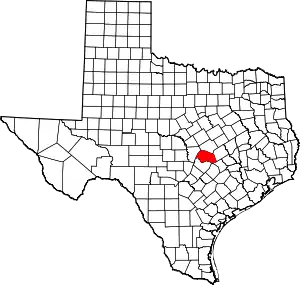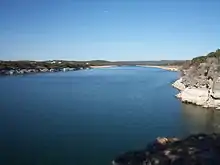Georgetown, Texas
Georgetown is a city in and the county seat of Williamson County, Texas, United States,[5] with a population of 47,400 at the 2010 census and a population of 79,604 at the 2019 Census estimate. Georgetown is the 7th fastest growing city in the U.S as of May 14 2019.
Georgetown, Texas | |
|---|---|
 | |
| Nicknames: Red Poppy Capital of Texas, G-Town | |
| Motto(s): "Sincerely Yours" | |
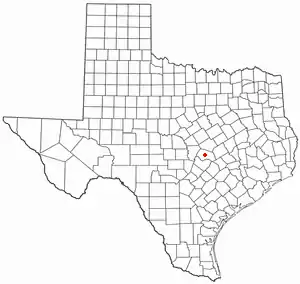 Location of Georgetown, Texas | |
 | |
| Coordinates: 30°39′4″N 97°40′53″W | |
| Country | United States |
| State | Texas |
| County | Williamson |
| Settled | 1840s |
| Incorporated | 1848 |
| Government | |
| • Type | Council-Manager |
| • Mayor | Dale Ross |
| • City Manager | David Morgan |
| Area | |
| • Total | 59.63 sq mi (154.44 km2) |
| • Land | 57.33 sq mi (148.49 km2) |
| • Water | 2.30 sq mi (5.95 km2) |
| Elevation | 755 ft (230 m) |
| Population (2010) | |
| • Total | 47,400 |
| • Estimate (2019)[2] | 79,604 |
| • Density | 1,388.47/sq mi (536.09/km2) |
| Demonym(s) | Townie |
| Time zone | UTC-6 (Central (CST)) |
| • Summer (DST) | UTC-5 (CDT) |
| ZIP codes | 78626, 78627, 78628, 78633 |
| Area code(s) | 512 and 737 |
| FIPS code | 48-29336 [3] |
| GNIS feature ID | 1357960 [4] |
| Website | Georgetown.org |
It is 30 miles (48 km) north of Austin. Founded in 1875 from four existing colleges, the oldest of which had been founded 35 years earlier,[6] Southwestern University is the oldest university in Texas. It is in Georgetown about one-half mile from the historic square.
Georgetown has a notable range of Victorian commercial and residential architecture. In 1976, a local historic ordinance was passed to recognize and protect the significance of the historic central business district. In 1977, the Williamson County Courthouse Historical District, containing some 46 contributing structures, was listed on the National Register of Historic Places.[7] Georgetown is also known as the "Red Poppy" Capital of Texas for the red poppy (Papaver rhoeas) wildflowers planted throughout the city. Georgetown's Red Poppy Festival, which attracts up to 30,000 visitors annually, is held in April each year on the historic square.
History
Prehistoric era
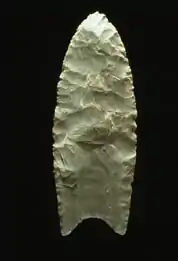
Georgetown has been the site of human habitation since at least 9,000 BC, and possibly considerably before that. The earliest-known inhabitants of the county, during the late Pleistocene (Ice Age), can be linked to the Clovis culture, a Paleo-Indian culture characterized by the manufacture of distinctive "Clovis points" for weapons. It first appeared around 9200 BC, and possibly as early as 11,500 BC,[8] at the end of the last glacial period.
One of the most important discoveries in recent times is that of the ancient skeletal remains dubbed the "Leanderthal Lady", because of its age and proximity to a nearby community Leander, Texas.[9] The site is immediately southwest of Georgetown and was discovered by accident by Texas Department of Transportation workers while core samples for a new highway were being drilled. The site has been extensively studied for many years, and samples carbon date the findings to the Pleistocene period, about 10,500 years ago (8500 BC). Archeological dig sites showing a much greater evidence of Archaic period inhabitants have been found in burned rock middens at several sites along the San Gabriel River, which have since been inundated by the manmade Granger Lake, and at the confluence of the North and South San Gabriel rivers in Georgetown.[10]
Early history
The earliest known historical occupants of the county, the Tonkawa, were a flint-working, hunting people who followed buffalo on foot and periodically set fire to the prairie to aid them in their hunts. During the 18th century, they made the transition to a horse culture and used firearms to a limited extent. Also, small numbers of Kiowa, Yojuane, Tawakoni, and Mayeye Indians apparently were living in the county at the time of the earliest Anglo settlements.[11] As these native populations thinned under pressure from non-indigenous settlements, the Comanche continued to raid native peoples' settlements in the county until the 1860s.
Modern history
Georgetown was named for George Washington Glasscock, who donated the land for the new town. Early American and Swedish pioneers were attracted to the area's abundance of timber and good, clear water. In addition, the land was inexpensive and fertile. Georgetown is the county seat of Williamson County, which was formed on March 13, 1848, after the early settlers petitioned the state legislature to create it from a portion of Milam County. The county was originally to have been named San Gabriel County, but was instead named after Robert McAlpin Williamson (known as "Three-legged Willie"), a Texas statesman and judge at the time.[12]

Georgetown was an agrarian community for most of the 19th and early 20th centuries. The Shawnee Trail, a cattle trail that led from Texas to the rail centers in Kansas and Missouri, crossed through Georgetown. The establishment of Southwestern University in 1873 and construction of a railroad in 1878 contributed to the town's growth and importance. A stable economy developed, based largely on agricultural activity. Cotton was the dominant crop in the area between the 1880s and the 1920s. In this period, Williamson County was once the top producer of cotton in Texas.[13]
At one time, Georgetown was served by two national railroads, the International-Great Northern Railroad, which eventually was merged into the Missouri Pacific, and the Missouri–Kansas–Texas Railroad. Both supported the transport of commodities to market: beef cattle and cotton. The regional Georgetown and Granger Railroad (GGR) was completed to Austin in 1904. Georgetown is served today by the Georgetown Railroad, a 'short line' railroad that uses portions of the former M-K-T and the I-GN to connect with the Union Pacific Railroad at Round Rock and at Granger.
In 1921 a low-pressure system from a hurricane settled in over Williamson County and brought more than 23 inches of rain in Taylor and more than 18 inches of rain in Georgetown. The flooding resulted in the deaths of 156 persons, many of them farm laborers. There was also extensive property damage, and Georgetown sought to flood control.[14]
The city/county (state?) completed construction of a dam more than 50 years later, on the north fork of the San Gabriel River, to create and impound Lake Georgetown, which opened officially on October 5,1979.[15] Both Georgetown and Round Rock own water rights to Lake Georgetown for municipal water use.
Population growth and industrial expansion continued modestly in the 20th century until about 1960, when residential, commercial, and industrial development, due to major growth and urban expansion of nearby Austin, greatly accelerated. In 2008, Fortune Small Business magazine ranked Georgetown as the second-best city in the nation to "live and launch" a new business.[16]
In March 2015, Georgetown announced that their municipal-owned utility, Georgetown Utility Systems, would begin buying 100% of power for its customers from wind and solar farms by 2017, effectively making the city 100% green-powered.[17]

Burkland-Frisk House

A densely overgrown, 1908–1910 Victorian house was found in Round Rock, Texas. (The site was later redeveloped for the La Frontera project.) The historic house was cut into pieces, and moved to Georgetown in 2006. There it was restored by Don Martin and Bill Smalling (1953–2008). It is located on San Gabriel Village Blvd, prominently overlooking the South San Gabriel River, and is now used as an office. It is known locally as the Burkland-Frisk House, as it was built by Leonard Frisk, an early settler in Williamson County, and was later owned by Tony Burkland, a relative.
In Round Rock, this house was originally across the street from an identical house, built in the same era. The latter was used in filming of The Texas Chain Saw Massacre. The houses were known as "pattern book" houses, ordered from a catalog and assembled on site from a package of materials brought by wagon from a local lumber company. They were likely built between 1908 and 1910.[18] Later the filmed house was cut and relocated to Kingsland, Texas. There it was redeveloped as part of the Antlers Hotel.[19]
Historic neighborhoods
In the 1970s, Georgetown's downtown was bleak and featureless. In an effort to modernize and compete with suburban retail development, building owners in the '50s and '60s had obscured some of their most unique resources – their historical retail buildings. The Texas-Victorian streetscape was plastered with stucco, aluminum covers, brick, and multiple layers of white paint. Community leaders began to reassess this retail stock, and work with the Main Street program of the National Trust for Historic Preservation to enhance the architectural heritage of the city.
In this period, economics also began to favor reuse of historic buildings, as the cost of borrowing money was soaring. In Georgetown, every bank offered significantly lower interest loans for the renewal of the town's grand Victorian buildings and facades. Rehabilitation tax credit programs in the 1980s made investing in historic property more profitable. By 1984, 40 rehabilitations were complete. Two years after Georgetown initiated its Main Street program, more than half the Main Street district had undergone some kind of positive transition.[20]
The city was recently named one of the best places to purchase a historic house. Today, Georgetown is home to one of the best preserved Victorian and pre-WW1 downtown historic districts, with the Beaux-Arts Williamson County Courthouse (1911) as its centerpiece. Due to its successful preservation efforts, Georgetown was named a national Main Street City in 1997, the first Texas city so designated.[21]
Georgetown has three National Register Historic Districts:
- Williamson County Courthouse District
- Belford National District
- The University Avenue/Elm Street District
Geography

Georgetown is located at 30°39′04″N 97°40′53″W (30.651187, −97.681333),[22] 26 miles (42 km) north of Austin's central business district. According to the United States Census Bureau, the city has a total area of 24.9 square miles (64.6 km2), of which 22.8 square miles (59.1 km2) are land and 2.1 square miles (5.4 km2) (8.42%) are covered by water.
Prior to the 2010 census, the city annexed part of the Serenada CDP, increasing its total area to 54.3 square miles (141 km2), of which, 52.1 square miles (135 km2) of it is land and 2.3 square miles (6.0 km2) is water-covered.[23][24]
The city is located on the northeastern edge of Texas Hill Country. Portions of Georgetown are located on either side of the Balcones Escarpment,[25] a fault line in which the areas roughly east of IH-35 are flat and characterized by having black, fertile soils of the Blackland Prairie, and the west side of the escarpment which consists mostly of hilly, karst-like terrain with little topsoil and higher elevations and which is part of the Texas Hill Country. Inner Space Cavern, a large cave, is a major tourist attraction found on the south side of the city, just west of Interstate 35, and is a large-scale example of limestone karst formations.
The North and Middle Forks of the San Gabriel River both run through the city. More than 30 miles of hike and bike trails, several parks, and recreation for both residents and visitors are provided along their banks.
- Major highways
 Interstate 35
Interstate 35 State Highway 29
State Highway 29 State Highway 195
State Highway 195 State Highway 130 (Toll Road)
State Highway 130 (Toll Road)
Endangered species
Georgetown is home to five endangered species. Two are songbirds protected by the Balcones Canyonlands Preserve in Travis and Williamson Counties. Invertebrate species found only in Williamson County live in the cave-like fissures on the west side of Georgetown. Karst topography is the name for the honeycomb-type limestone formations (including caves, sinkholes, and fissures) that are typical in the county's limestone geology west of I-35.
In the 1990s, a small group of concerned landowners and developers formed the Northern Edwards Aquifer Resource Council. Their goal was to identify and preserve a sufficient number of caves with endangered species to ensure survival of the species. Ultimately they wanted to obtain a United States Fish and Wildlife Service 10-A permit (known as an Incidental Take Permit) for the entire county by such actions.[26] By gaining the permit, these species would be preserved through voluntary donations of land rather than by the county or state requiring setbacks and other involuntary means. The group documented their successful work in an environmental impact statement to the county in 2002, and a county-wide 10-A permit was obtained in October 2008.[27]
Climate
According to the Köppen climate classification system, Georgetown has a humid subtropical climate, Cfa on climate maps.[28]
Georgetown, like much of Central Texas, is characterized by its long, hot summers and cooler, mild winters. The average summer temperature typically reaches 100 °F for several days during July and August. It is common for highs to be near 90 °F well into October, but by this time, the nights are noticeably cooler.
Winters in Georgetown have highs in the 50s and 60s, with a few days dropping near freezing, causing one or two ice storms per season. A few days reach well above the average. The region may have temperatures in the 80s well into December and 70s in January.
Fall, winter, and spring all average about two to three inches of rain per month, while July and August are the driest, averaging only one to two inches and sometimes no precipitation at all. Most of what rain does fall during the long summer comes from the outflow of Gulf storms that are often pushed away from the region by a large summer high-pressure system.
Georgetown has more than 225 days classified as mostly sunny to sunny, among a total of more than 300 days of at least partly cloudy skies per year.
Demographics
| Historical population | |||
|---|---|---|---|
| Census | Pop. | %± | |
| 1870 | 479 | — | |
| 1880 | 1,354 | 182.7% | |
| 1890 | 2,447 | 80.7% | |
| 1900 | 2,790 | 14.0% | |
| 1910 | 2,096 | −24.9% | |
| 1920 | 2,871 | 37.0% | |
| 1930 | 3,583 | 24.8% | |
| 1940 | 3,682 | 2.8% | |
| 1950 | 4,951 | 34.5% | |
| 1960 | 5,218 | 5.4% | |
| 1970 | 6,395 | 22.6% | |
| 1980 | 9,468 | 48.1% | |
| 1990 | 14,842 | 56.8% | |
| 2000 | 28,339 | 90.9% | |
| 2010 | 47,400 | 67.3% | |
| 2019 (est.) | 79,604 | [2] | 67.9% |
| U.S. Decennial Census[29] | |||
As of the 2010 census, the population density was 990.4 people per square mile (382.4/km2).[30]
As of the census of 2000,[3] 28,339 people, 10,393 households, and 7,711 families resided in the city. The population density was 1,241.3 people per square mile (479.3/km2). The 10,902 housing units averaged 477.5 per square mile (184.4/km2). The racial makeup of the city was 85.39% White, 3.39% African American, 0.35% Native American, 0.67% Asian, 0.05% Pacific Islander, 8.31% from other races, and 1.83% from two or more races. Hispanics or Latinos of any race were 18.07% of the population.[3]
Of the 10,393 households, 31.8% had children under the age of 18 living with them, 61.6% were married couples living together, 9.5% had a female householder with no husband present, and 25.8% were not families; 21.5% of all households were made up of individuals, and 9.3% had someone living alone who was 65 years of age or older. The average household size was 2.52 and the average family size was 2.92.[3]
In the city, the population was distributed as 23.4% under the age of 18, 11.4% from 18 to 24, 26.3% from 25 to 44, 21.3% from 45 to 64, and 17.7% who were 65 years of age or older. The median age was 37 years. For every 100 females, there were 95.0 males. For every 100 women age 18 and over, there were 91.1 men.[3]
The median income for a household in the city was $54,098, and for a family was $63,338. Males had a median income of $40,541 versus $27,082 for females. The per capita income for the city was $24,287. About 4.4% of families and 7.2% of the population were below the poverty line, including 9.3% of those under age 18 and 3.9% of those age 65 or over.[3]
Economy
List of major employers
Georgetown's major employers and number of employees as of June 2009:[31]
- Williamson County Government (1,700)
- Georgetown Independent School District (1,650)
- St. David's Georgetown Hospital (650)
- Airborn, Inc. (550)
- City of Georgetown (455)
- Southwestern University (450)
- Caring Home Health (400)
- Wesleyan Homes, Inc. (290)
- Sun City (Del Webb) (260)
Interstate Highway 35 location

Without question, the single most important issue relating to economic development was the location of Interstate 35 through Georgetown. Originally, when first conceived, a Georgetown route was very much in doubt, as most alignments had the road going through or near Taylor. At the time, Taylor was the economic hub of Williamson County as the center for cotton and cattle.[32] While the Taylor leadership supported the Taylor route, local farmers opposed it. The interstate required then-unheard-of 300 feet of right of way across the entire county and through nearby Taylor farms, and many farmers worried that their homes might get cut off from their fields. Also, concerns were expressed about noise relating to cattle and other farm animals. Meanwhile, Round Rock and Georgetown leadership strongly lobbied for a route along the Balcones Escarpment fault line, which would later become U.S. Highway 81 and then eventually I-35.[33]
Sun City
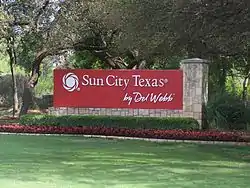
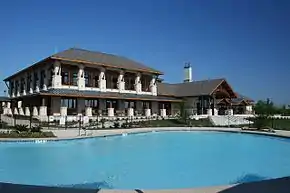
The second-largest economic development activity in Georgetown history was the selection in 1995 of Georgetown as the site for the first-ever Sun City location in Texas. Originally called Sun City Georgetown, the project today is called Sun City Texas due to its size and because it draws residents from all over the state. As of 2010, about 11,500 people live in the massive, 5,300-acre (and expanding) community, with an average net worth over $1,000,000 per person. The economic stimulus, creation of sales tax, banking and investment, and the high rate of community support and volunteerism has had an enormous effect on Georgetown.[34]
Opened in June 1995, Sun City Texas is a 5,300-acre (21 km2) age-restricted community located in Georgetown, about 10 miles west of I-35 on Williams Drive (RM 2338). It is part of the chain of Sun City communities started by the Del Webb Corporation (now a division of Pulte Homes).[35] Residency is restricted to persons over age 55 (at least one person in a couple has to be 55 or older).[36] Sun City Texas is made up mostly of single-family dwellings, but also has duplexes. It is legal to drive golf carts on the streets in the development (under a special Texas license exemption with help from Del Webb), and most shopping and the community facilities all have special parking slots for them.[37]
Opposition to the project has been vocal at times, especially at the start during the zoning process, with arguments against the size of the community, its effect on Georgetown as a family-oriented town, concerns about the costs of providing city utilities, concern about lowered property taxes fixed for retirees under Texas law, and the disproportionate effect of city voting.[38]
Georgetown is considered to be one of the best places to retire in the nation because of its fairly warm climate year round, close proximity to both the countryside and Austin, excellent medical care including Alzheimer's care, and its increasing population of retirees.[39] In 2007, Georgetown was named by Retirement Places Rated (seventh edition) as the Best Place in America to Retire.[40] Part of this is because Sun City Texas, a large master-planned community for "active adults 55 and over", calls Georgetown home. Fifteen years after the project groundbreaking, Sun City is now home to nearly 11,000 residents—nearly 70% retired with a median age of 65—and has been a driving force behind growth, development, and the very shape of Georgetown since its inception.[39]
Numerous other active adult communities are also found in Georgetown, including the well-respected Wesleyan at Estrella, the Oaks at Wildwood, Heritage Oaks, and many others.[41] Various projects offer differing levels of care, including assisted living. The city, county, and churches also maintain compassionate-care facilities for the elderly at the Bluebonnet Community Residence.
Energy policy
Georgetown is the first Texas city to operate entirely on renewable energy.[42] Georgetown's projected power expenditures were $33 million for 2016 (spent $40 million); $39 million for 2017 (spent $46 million) and $45 million for 2018 (spent $53 million). It made up the shortfall through lower capital investments, rate adjustments, and "higher revenue" (tax).[43] The average home power bill in the city increased 22% in 2019 compared to 2018.[44]
Government and politics
City government
The City of Georgetown is a home rule city and adopted its initial home-rule charter on April 24, 1970. As provided by its charter, Georgetown has a council-manager form of government. Under this form of government, the city council provides leadership by establishing the city's goals and policies. The city council appoints a full-time city manager to achieve the desired end set by the city council. The manager oversees the day-to-day activities of the city and all city departments and executes council-established laws and policies. The city council is composed of seven council members elected by geographic districts:[45]
- District 1 – Mary Calixtro
- District 2 - Shawn Hood
- District 3 – Michael Triggs
- District 4 – Steve Fought
- District 5 – Kevin Pitts
- District 6 – Rachael Jonrowe
- District 7 – Tommy Gonzalez
A mayor is elected at-large. Each position is elected for a term of three years, with council districts with staggered election dates. Josh Schroeder was elected mayor in 2020 with 64.54% of the vote and will serve until May 2023. David Morgan was hired by the City Council as the City Manager in 2015.[46]
State and national representation
- Texas House of Representatives:
- State Representative District 20 – Terry Wilson (R) – elected November 2012
- State Representative District 52 – James Talarico (D) – elected November 2018
- Texas Senate
- Texas Senate District 5 – Charles Schwertner (R) – elected November 2012
- United States House of Representatives:
Education

The City of Georgetown is served by the Georgetown Independent School District and Georgetown High School, a National Blue Ribbon Award school, serves the community. Georgetown opened a second high school, East View High, in 2008. The graduating class of 2014 was the first class of students to graduate from East View as a full high school. Up to that point, East View High School had started as a freshman-only campus and added on one grade at a time as those students moved up.
Georgetown is also the home of Southwestern University, a private, four-year, undergraduate, liberal arts college.[47] Founded in 1875,[48] Southwestern is the oldest university in Texas. The school is affiliated with the United Methodist Church, although the curriculum is nonsectarian. Southwestern offers 40 bachelor's degrees in the arts, sciences, fine arts, and music, as well as interdisciplinary and pre-professional programs. The university is accredited by the Southern Association of Colleges and Schools and the National Association of Schools of Music.
Sites of interest



- Williamson County Courthouse
- Williamson County Art Guild
- Berry Springs Park
- Sun City Texas
- Blue Hole Park
- San Gabriel Park
- Georgetown Firefighters Museum
- Inner Space Cavern
- Lake Georgetown
- Georgetown Municipal Airport
- The Levy House
- Palace Theatre
- Georgetown Art Center
- Garey Park
Movies filmed in Georgetown
List partly from material provided by the Texas Film Commission[49]
- Friday Night Lights (Movie & TV series)
- Leadbelly
- Grindhouse
- Bernie
- My Boyfriend's Back
- Natural Selection
- The Big Picture
- Picnic
- Über Goober
- Pair of Aces
- What's Eating Gilbert Grape
- Night Job
- Johnny Be Good
- Michael – a 1996 Nora Ephron film
- Varsity Blues
- Lemmy Lemmy
- Where the Heart Is
- Shady Grove
- The Prophet of Armageddon
- Dazed and Confused
- Hope Floats
- Temple Grandin
- Men, Women & Children
Notable people
- Nolan Ryan, former Major League Baseball player[50]
- W. E. "Pete" Snelson, former member of both houses of the Texas State Legislature from Midland; spent his last years in Georgetown, where he died in 2014[51]
- Paul Womack, retiring judge of the Texas Court of Criminal Appeals[52]
- Ryan Ludwick, a Major League Baseball outfielder who last played for the Cincinnati Reds[53]
- Matt Dominguez, a Grey Cup winner and 2006 All-Star wide receiver with the Saskatchewan Roughriders of the Canadian Football League[54]
- Brian Anderson, sports announcer: Turner Sports, Milwaukee Brewers[55]
- Mason Crosby, NFL kicker, Green Bay Packers, 2010 Super Bowl XLV champion[56]
- Granger Smith, singer-songwriter, Country Music, 2016 BMI Awards won the BMI Country Award, 2017 IHeartRadio Music Awards nominated for Best New Country Artist
- Conan Gray, singer-songwriter, internet personality, awarded 'Best YouTube Musician' at the 2019 Shorty Award.[57]
References
- "2019 U.S. Gazetteer Files". United States Census Bureau. Retrieved August 7, 2020.
- "Population and Housing Unit Estimates". United States Census Bureau. May 24, 2020. Retrieved May 27, 2020.
- "U.S. Census website". United States Census Bureau. Retrieved 2008-01-31.
- "US Board on Geographic Names". United States Geological Survey. 2007-10-25. Archived from the original on 2012-02-26. Retrieved 2008-01-31.
- "Find a County". National Association of Counties. Archived from the original on 2011-05-31. Retrieved 2011-06-07.
- https://www.southwestern.edu/about-southwestern/our-history/
- "Georgetown Mainstreet History". Archived from the original on 6 July 2010. Retrieved 3 May 2017.
- "Handbook of Texas Online, "Gault Site" entry". Texas State History Association. Archived from the original on 2011-07-10. Retrieved 2010-07-18.
- Thompson, Karen R.; Jane H. Digesualado. Historical Round Rock Texas. Austin, Texas: Nortex Press (Eakin Publications). pp. 4, 7.
- ""Pre-history" Handbook of Texas entry". Tshaonline.org. Archived from the original on 2017-11-11. Retrieved 2017-12-06.
- ""Williamson County" Handbook of Texas entry". Tshaonline.org. Archived from the original on 2018-05-09. Retrieved 2017-12-06.
- "Williamson, Robert McAlpin (Three Legged Willie)" Archived 2018-05-09 at the Wayback Machine. Handbook of Texas Online. Retrieved 2010-07-26.
- McLemore, Andrew (August 15, 2010). "Cotton County". Williamson County Sun.
- Scarbrough, Linda (2009). Road, River and Good Ol' Boy Politics: A Texas County's Path from Farm to Supersuburb. Austin, Texas: Texas State Historical Association. pp. 36, 42. ISBN 9780876112359.
- Scarbrough, Linda (2009). Road, River and Good Ol' Boy Politics: A Texas County's Path from Farm to Supersuburb. Austin, Texas: Texas State Historical Association. p. 233. ISBN 9780876112359.
- "100 Best places to live and launch 2008: Top 100 - Fortune Small Business Magazine". money.cnn.com. Archived from the original on 2019-11-17. Retrieved 2019-11-17.
- Daniel Gross (March 23, 2015). "The Texas Town That Just Quit Fossil Fuels". Slate. Archived from the original on March 8, 2017. Retrieved March 7, 2017.
- Matt Phillips. "TCM Sister House". Texaschainsawmassacre.net. Archived from the original on 8 January 2011. Retrieved 5 February 2011.
- Dorsch, Jeff (20 January 2002). "Twin to Texas Chainsaw Massacre House Moves to Georgetown". Williamson County Sun. Archived from the original on 20 October 2019. Retrieved 13 December 2019.
- Georgetown Texas. Archived 2010-02-22 at the Wayback Machine National Trust for Historic Places. 1977.
- Georgetown Texas. Archived 2010-02-22 at the Wayback Machine Georgetown, Texas 1997 Great American Main Street Award Winner. National Trust for Historic Places. 1997.
- "US Gazetteer files: 2010, 2000, and 1990". United States Census Bureau. 2011-02-12. Retrieved 2011-04-23.
- "Population and Housing Unit Counts, 2010 Census of Population and Housing" (PDF). Texas: 2010. Archived (PDF) from the original on 2017-02-13. Retrieved 2017-01-06.
- "Boundary Map of Georgetown, Texas". MapTechnica. Archived from the original on 2017-01-06. Retrieved 2017-01-06.
- Balcones Escarpment from the Handbook of Texas Online. Retrieved 11 May 2010. Texas State Historical Association
- Barrios, Jennifer (30 September 2004). "Grant will help creepier residents. $2.35 million to save beetles, spiders and other endangered species". Austin American-Statesman. p. A1.
- Doolittle, David (October 23, 2008). "Plan to protect species gets OK; U.S. Fish & Wildlife Service gives approval". Austin American-Statesman.
- "Georgetown, Texas Köppen Climate Classification (Weatherbase)". Weatherbase. Archived from the original on 4 March 2016. Retrieved 3 May 2017.
- "Census of Population and Housing". Census.gov. Retrieved June 4, 2015.
- "Georgetown QuickFacts". United States Census Bureau. Archived from the original on 10 July 2014. Retrieved 22 August 2014.
- "Invest in Georgetown » Major Employers » Print". July 6, 2010. Archived from the original on 2010-07-06.
- Scarbrough, Linda (2009). Road, River and Good Ol' Boy Politics: A Texas County's Path from Farm to Supersuburb. Austin, Texas: Texas State Historical Association. p. Chapter 13. ISBN 9780876112359.
- Scarbrough, Linda (2009). Road, River and Good Ol' Boy Politics: A Texas County's Path from Farm to Supersuburb. Austin, Texas: Texas State Historical Association. p. 245. ISBN 9780876112359.
- Rasmussen, Blake; Suzanne Haberman (August 13, 2010). "Fifteen years later, Sun City still drives city growth". Community Impact Newspaper. p. A1. Archived from the original on April 20, 2011. Retrieved August 17, 2010.
- Novak, Shonda (April 9, 2009). "Builders Pulte, Centex to combine in deal with national significance, Merger might be sign of industry rebound". Austin American-Statesman. p. B–07. Archived from the original on June 9, 2011. Retrieved 2010-07-18.
- Ward, Pamela (November 9, 1996). "ON COURSE FOR A GRAND OPENING IN SUN CITY". Austin American-Statesman. p. B–1. Archived from the original on June 9, 2011. Retrieved 2010-07-18.
- "Del Webb Sun City Texas, About Our Community". Archived from the original on June 18, 2012. Retrieved July 18, 2010.
- Banta, Bob (April 10, 2008). "Mayoral hopefuls let their work talk". Austin American-Statesman. pp. W–01.
- Rasmussen, Blake; Suzanne Haberman (August 13, 2010). "Fifteen years later Sun City still drives Georgetown growth". Community Impact Newspaper. Archived from the original on April 20, 2011. Retrieved August 16, 2010.
- David Savageu (2007-08-24). Retirement Places Rated (Seventh ed.). Wiley. ISBN 9780470194362.
- Shaver, Karin (October 7, 2007). "New Housing Developments; The Wesleyan at Estrella". Community Impact News. Archived from the original on July 13, 2011. Retrieved August 16, 2010.
- Tilove, Jonathan (2017-10-23). "How Georgetown's GOP mayor became a hero to climate change evangelists". Austin American. Archived from the original on 2018-11-20. Retrieved 2018-11-20.
- Osborn, Claire. "Georgetown renegotiating solar, wind power contracts". Austin American-Statesman. Archived from the original on 15 July 2019. Retrieved 8 June 2019.
- "Archived copy". Archived from the original on 2019-11-05. Retrieved 2019-11-07.CS1 maint: archived copy as title (link)
- "City Council – City Government". Government.georgetown.org. Archived from the original on 29 March 2019. Retrieved 8 June 2019.
- Pham, Tadd (2021-01-21). "City Management". City Government. Archived from the original on 15 June 2017. Retrieved 3 May 2017.
- "Handbook of Texas Online, "Southwestern University" entry". Texas State History Association. Archived from the original on 2011-07-10. Retrieved 2019-04-12.
- https://williamson-county-texas-history.org/GEORGETOWN_TEXAS/Original_Site_of_Southwestern_niversity-Georgetown-Historical_Marker.html
- Katie Kelley, Office Manager – Texas Film Commission. Email July 23, 2009
- "Nolan Ryan Stats". Baseball-Reference.com. Archived from the original on 2017-06-25. Retrieved 2019-11-17.
- "W. E. "Pete" Snelson (1923-2014)". The Odessa American. Archived from the original on July 2, 2014. Retrieved May 1, 2014.
- "Paul Womack's Biography". Project Vote Smart. Archived from the original on December 18, 2014. Retrieved December 17, 2014.
- "Ryan Ludwick Stats". Baseball-Reference.com. Archived from the original on 2019-11-06. Retrieved 2019-11-17.
- "Former Rider Dominguez giving back to sport that made him a star". CFL.ca. 2018-11-30. Archived from the original on 2019-11-17. Retrieved 2019-11-17.
- "Brewers TV announcer Brian Anderson has hectic spring schedule that includes basketball and golf, too". Milwaukee Journal Sentinel. Retrieved 2019-11-17.
- "Mason Crosby". www.packers.com. Retrieved 2019-11-17.
- "Conan Gray – The Shorty Awards". shortyawards.com. Archived from the original on 2019-03-20. Retrieved 2019-07-11.
External links
| Wikimedia Commons has media related to Georgetown, Texas. |
| Wikisource has the text of a 1911 Encyclopædia Britannica article about Georgetown, Texas. |
